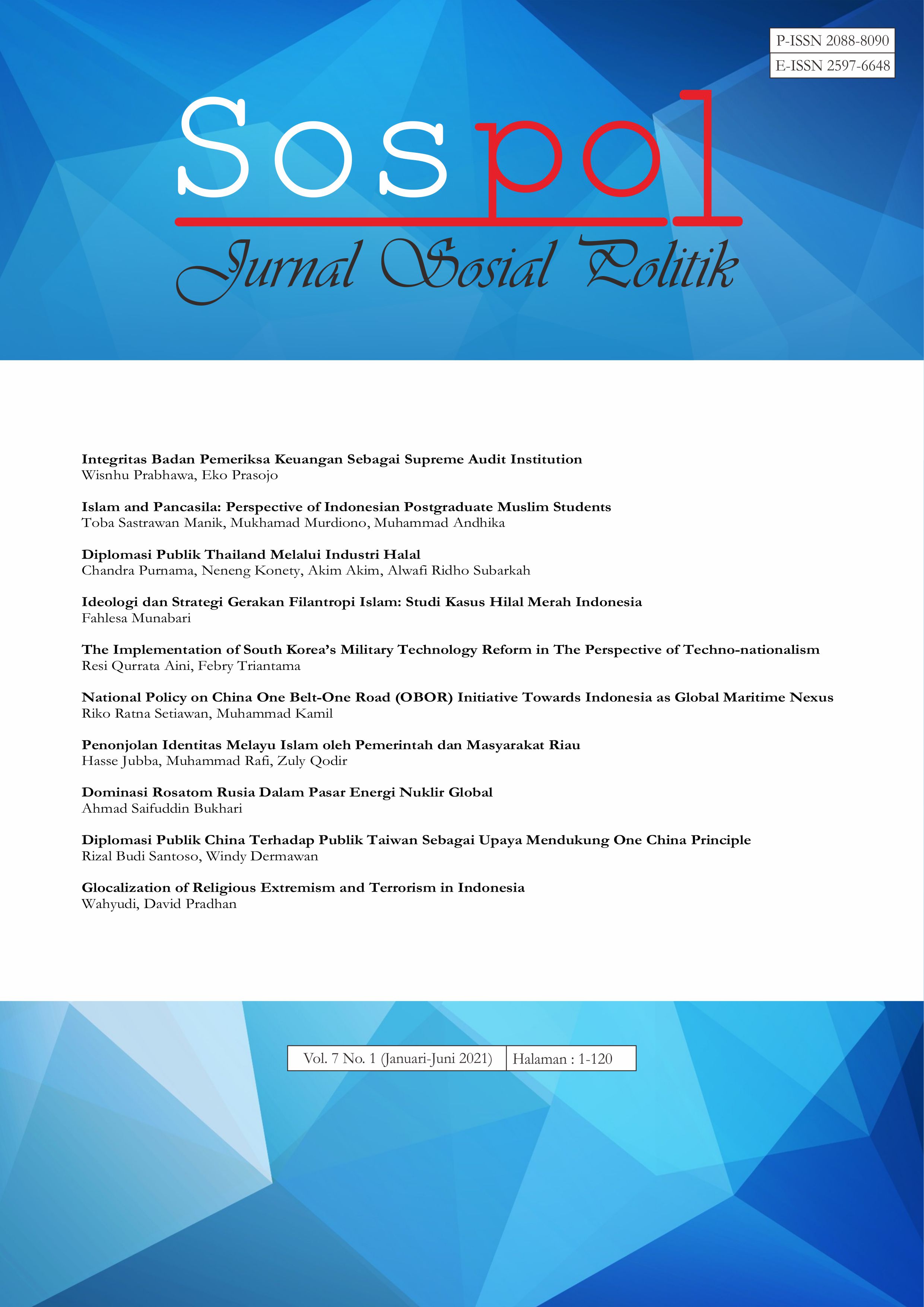Diplomasi Publik China Sebagai Upaya Mendukung One China Principle
DOI:
https://doi.org/10.22219/sospol.v7i1.15124Keywords:
China, One China Principle, Public Diplomacy, TaiwanAbstract
Abstract
This article aims to explain the Chinese public diplomacy towards the Taiwanese public as an effort to support one China principle. Researchers see that this one China principle is a stepping stone for China and Taiwan in establishing interactions based on the 1992 consensus. In analyzing, the researcher used the concept of Mark Leonard with the aim to find out how Chinese public diplomacy towards the Taiwanese public was in an effort to support one China principle. The research method used in this research is a qualitative method that is supported by collecting data through literature studies and also reducing the data in conducting data analysis. The results of this study indicate that Chinese public diplomacy towards Taiwan as an effort to support one China principle has gained support for this one China principle coming from the Kuomintang Party and Taiwanese businessmen based on the 1992 consensus.
Downloads
References
Aspinwall, N. (2018). Taipei-Shanghai Forum Puts Ko Wen-je’s China Views Into Focus. Retrieved November 16, 2019, from The Diplomat website: https://thediplomat.com/2018/12/taipei-shanghai-forum-puts-ko-wen-jes-china-views-into-focus/
Beckershoff, A. (2014). The KMT-CCP Forum: Securing Consent for Cross-Strait Rapprochement. Journal of Current Chinese Affairs, 43(1), 213–241. https://doi.org/10.1177/186810261404300108
Cull, N. J. (2009). Public Diplomacy before Gullion: The Evolution of a Phrase. In N. Snow & P. M. Taylor (Eds.), Routledge Handbook of Public Diplomacy. New York: Routledge.
D’Hooghe, I. (2011). The Expansion of China’s Pubblic Diplomacy System. In J. Wang (Ed.), Soft Power in China, Public Diplomacy through Communication (pp. 19–36). New York: Palgrave Macmillan.
Dreyer, E. L. (2008). The Myth of “One China.” In P. C. Y. Chow (Ed.), The One China Dilemma. New York: Palgrave Macmillan.
Hartig, F. (2015). Communicating China to the World: Confucius Institutes and China’s Strategic Narratives. Politics, 35(3–4), 245–258. https://doi.org/10.1111/1467-9256.12093
Hille, K. (2019). Taiwan primaries highlight fears over China’s political influence. Retrieved November 28, 2019, from Financial Times website: https://www.ft.com/content/036b609a-a768-11e9-984c-fac8325aaa04
Hioe, B. (2019). The Return of Media Monopoly? Retrieved February 8, 2020, from newbloommag.net website: https://newbloommag.net/2019/04/03/media-monopoly-return/
Hocking, B. (2005). Rethinking the ‘New’ Public Diplomacy. In The New Public Diplomacy, Soft Power in International Relations (pp. 28–45). New York: Palgrave Macmillan.
Huang, J. (2017). Xi Jinping’s Taiwan Policy: Boxing Taiwan In with the One-China Framework Chapter. In Taiwan and China (pp. 239–248). California: University of California Press.
Hung, T.-C. (2017). Rethinking Public Diplomacy : A Study of China Exerting its Influence on Taiwan by Tzu-Chieh Hung to A Thesis Submitted to the Graduate Scholl of Asian-Pacific Studies of Waseda University , in partial fulfillment of the requirements for the degree of Doc (the Graduate Scholl of Asian-Pacific Studies of Waseda University). Retrieved from https://core.ac.uk/download/pdf/159504351.pdf
Jiang, Y. (2017). Taiwan’s National Identity and Cross-Strait Relations. In L. Dittmer (Ed.), Taiwan and China (p. 29). California: University of California Press.
Kang, J. Y. (2003). From “Creeping Independence” to Reluctant Realism? China-Taiwan Relations under the DPP. International Area Studies Review, 6(2), 21–42. https://doi.org/10.1177/223386590300600202
Lamont, C. (2015). Research Methods In International Relations. London: Sage Publications Ltd.
Lan, T. J. (2017). Confucius Institue at Universitas Al Azhar, Jakarta: The unseen power of China. Wacana, 18(1), 148–182. https://doi.org/10.17510/wacana.v18i1.576.Thung
Lee, C. Y., & Yin, M. X. (2017). Chinese investment in Taiwan: A challenge or an opportunity for Taiwan? Journal of Current Chinese Affairs, 46(1), 37–59.
Leonard, M., Stead, C., & Smewing, C. (2002). Public Diplomacy. London: Foreign Policy Centre.
Lin, G. (2019). Taiwan’s Party Politics and Cross-Strait Relations in Evolution (2008–2018). New York: Palgrave Macmillan.
Lin, S. S. (2016). Taiwan’s China Dilemma Contested Identities and Multiple Interests in Taiwan’s Cross-Strait Economic Policy. California: Stanford University Press.
Lin, Y., & Hsieh, J. F. sheng. (2016). Change and Continuity in Taiwan’s Public Opinion on the Cross-Strait Economic Interactions. Journal of Asian and African Studies, 52(8), 1103–1116. https://doi.org/10.1177/0021909616649210
Matsuda, Y. (2015). Cross-Strait Relations under the Ma Ying-jeou administration: From Economic to Political Dependence? Journal of Contemporary East Asia Studies, 4(2), 3–35. https://doi.org/10.1080/24761028.2015.11869083
Melissen, J. (2005). The New Public Diplomacy Soft Power in International Relations. New York: Palgrave Macmillan.
Pamment, J. (2012). New public diplomacy in the 21st century: A comparative study of policy and practice. In New Public Diplomacy in the 21st Century: A Comparative Study of Policy and Practice. https://doi.org/10.4324/9780203096734
Pei-chih, L., Tsung-han, M., & Huang, F. (2018). Twin-city forum to focus on economic issues: Taipei mayor | Cross-Strait Affairs | FOCUS TAIWAN - CNA ENGLISH NEWS. Retrieved November 29, 2019, from focustaiwan.tw website: http://focustaiwan.tw/news/acs/201812190010.aspx
Rawnsley, G. (2012). Approaches to soft power and public diplomacy in China and Taiwan. Journal of International Communication, 18(2), 121–135. https://doi.org/10.1080/13216597.2012.695744
Santoso, R. B., Surya, A., Hidayat, T., & Dermawan, W. (2020). China ’ s Public Diplomacy in Taiwan. Atlantis Press, 391, 52–55.
Theo, R., & Leung, M. W. H. (2018). China’s Confucius Institute in Indonesia: Mobility, frictions and local surprises. Sustainability (Switzerland), 10(2). https://doi.org/10.3390/su10020530
Tuch, H. (1990). Communicating with the World: US Public Diplomacy Overseas. New York: St. Martin’s Press.
Wang, N. T. (2014). Taiwan ’ s Economic Relations with Mainland. Asain Affairs, 18(2), 99–119.
Weng, L. C. D. (2017). Can economic profit influence public opinion? Observing generational change on cross-strait relations in Taiwan. Asian Journal of Comparative Politics, 2(4), 362–384. https://doi.org/10.1177/2057891116687878
Xiaowei, L., & Baiting, C. (2016). The Cross-Strait Peace Development Forum is closed, and the Qing Lu will recruit 260 Taiwanese teachers. Retrieved November 16, 2019, from chinatimes.com website: https://www.chinatimes.com/newspapers/20161104000368-260108?chdtv
Zaharna, R. S. (2010). Battles to Bridges, U.S. Strategic Communication and Public Diplomacy after 9/11 Studies (R. S. Zaharna, Ed.). New York: Palgrave Macmillan.
Downloads
Published
How to Cite
Issue
Section
License
Copyright (c) 2021 Rizal Budi Santoso, Windy Dermawan

This work is licensed under a Creative Commons Attribution-NonCommercial-ShareAlike 4.0 International License.
Authors who publish with this journal agree to the following terms:
- Authors retain copyright and grant the journal right of first publication with the work simultaneously licensed under a Creative Commons Attribution-ShareAlike 4.0 International License that allows others to share the work with an acknowledgement of the work's authorship and initial publication in this journal.
- Authors are able to enter into separate, additional contractual arrangements for the non-exclusive distribution of the journal's published version of the work (e.g., post it to an institutional repository or publish it in a book), with an acknowledgement of its initial publication in this journal.
- Authors are permitted and encouraged to post their work online (e.g., in institutional repositories or on their website) prior to and during the submission process, as it can lead to productive exchanges, as well as earlier and greater citation of published work (See The Effect of Open Access).

This work is licensed under a Creative Commons Attribution-ShareAlike 4.0 International License.



















